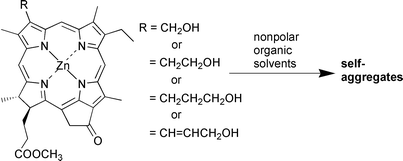Synthesis and self-aggregation of zinc chlorophylls possessing an ω-hydroxyalkyl group: effect of distance between interactive hydroxy group and chlorin moiety on aggregation†
Abstract
Zinc 131-oxochlorins 2, 3 and 3D possessing

* Corresponding authors
a Department of Bioscience and Biotechnology, Faculty of Science and Engineering, Ritsumeikan University, Kusatsu, Shiga 525-8577, Japan
b “Form and Function” PRESTO, Japan Science and Technology Corporation (JST), Kusatsu, Shiga 525-8577, Japan
Zinc 131-oxochlorins 2, 3 and 3D possessing

 Please wait while we load your content...
Something went wrong. Try again?
Please wait while we load your content...
Something went wrong. Try again?
S. Yagai and H. Tamiaki, J. Chem. Soc., Perkin Trans. 1, 2001, 3135 DOI: 10.1039/B107902F
To request permission to reproduce material from this article, please go to the Copyright Clearance Center request page.
If you are an author contributing to an RSC publication, you do not need to request permission provided correct acknowledgement is given.
If you are the author of this article, you do not need to request permission to reproduce figures and diagrams provided correct acknowledgement is given. If you want to reproduce the whole article in a third-party publication (excluding your thesis/dissertation for which permission is not required) please go to the Copyright Clearance Center request page.
Read more about how to correctly acknowledge RSC content.
 Fetching data from CrossRef.
Fetching data from CrossRef.
This may take some time to load.
Loading related content
